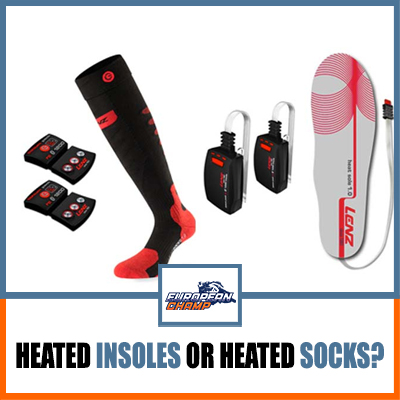If you are fairweather or pro biker, you will know how miserable it is to have cold feet are riding your bike.

To be honest, it’s miserable at any time having cold feet, but when riding and changing gears, it can almost become a reason to stop and try to recover some kind of circulation to the foot.
If you are a casual rider or enthusiast, this also applies. If you want to ride your bike on a crisp sunny winter’s day, but your cold feet ruin the experience?
Well, you can keep your feet toasty on long rides with heated insoles or heated socks!
Below you’ll figure out what option is best for you.
Heated Insoles, How Well Do They Work?
Well, first of all, let’s look at what we get in the form of heated insoles. As you would expect, you get a pair of insoles, no surprises there.
You also receive a small charging unit. Yes, you need to charge your insoles before using them, which some of us may find a pain in the neck.
Also, there is a key fob device that allows you to alter the temperature settings.
The first thing you may notice is the insoles are pretty thick to accommodate the battery.
This could be problematic if you are buying insoles retrospectively. Most of us buy our boots, so they fit snug,
So, be aware from the very outset when ordering heated insoles that you may not be able to get your boots on when fitted!
Insoles do not come sized and sometimes need to be trimmed to fit.
However, suppose you consider the back heel part of the insole is all battery. In that case, the heating element is towards the toes, so trimming needs to be done carefully, particularly for a smaller boot.
Another consideration is your boots need to be 100% waterproof. If your boots leak even a slight amount, this could cause the insoles to fail and make the warranty invalid.
Insoles are perfect for average moisture generated by the body.
When fitted, a decent amount of heat comes from the insoles, but one concern is it’s difficult to know from outside of your boot which heats setting is selected.
Typically if you are a larger rider, the insole can support substantial weight, so no worries in that department.
It’s a great idea not to jump in the boots or run. The circuits can be a little sensitive to impact.
Cleaning the insoles is not easy with any insole, but adding a heating element and charging circuits makes life even more difficult.
In terms of the life of the heated insoles, you can expect around three hundred charges before things start to fail. Premium insoles will last longer.
The main issue is that the insoles must be removed from the boots each time charging is required, which is a slight hassle, particularly if you have hands like spades, and dexterity is not your forte.
Heated Socks
We have looked at the insoles, so now it’s only fair we appraise heated socks with the same critical eye.
Heated single-core socks with micro wiring are a different prospect when it comes to keeping your feet warm.
With the wind blasting over your feet while resting on the pegs, even with good boots, you often need something more to keep warm, significantly when the weather is cooling.
Socks come with a heating element that wraps around the sole and instep of your foot, and this provides good all-over heating to the foot.
The socks can be knee-length, but the heating is just to the foot.
A small cable runs to the control model, which is mounted close to the garter of the sock.
Charges can last 10 hours with lithium-ion batteries, making the heated sock an easy option for most riders.
The socks come in a generous range of sizes to fit most riders. In addition, it is possible with some manufacturers to wire the socks to the belt and use a central power supply that may be heating your jacket and gloves.
The socks are perfect for any rider but come into their own for pro riders and casual riders on a longer ride.
The highest heat output for some manufactures is 135 degrees F for two hours—the control drops in 25 degrees increments to a minimal set of 25 degrees.
If you opt for a premium sock, you will have two options for securing the control module. You can wear a support harness that is just velcro with a pocket for the control module or uses a clip assembly and mount the control module on the outside of your boot.
The latter gives the rider the easy option for raising and lowering the temperature of the socks without lifting the trouser leg.
Alternate power source, the premium socks come with a Y piece cable that threads inside the trousers to the waist where the cable can connect to an alternate power source if desired.
My only reservations about the socks are that a premium sock can be as much as three times more expensive than an insole, which makes choosing a little harder.
The Bottom Line
This is a personal choice based on the cost for many riders. If you require performance and versatility, then heated socks are the best option.
However, if you are not an everyday rider throughout the year, the extra cost of the socks would kill the deal for me despite the convenience of the socks.
Insoles and socks both work and provide heat to the feet and extend the riding season for the casual biker.
If it comes to a straight winner or loser, the socks win hands down.